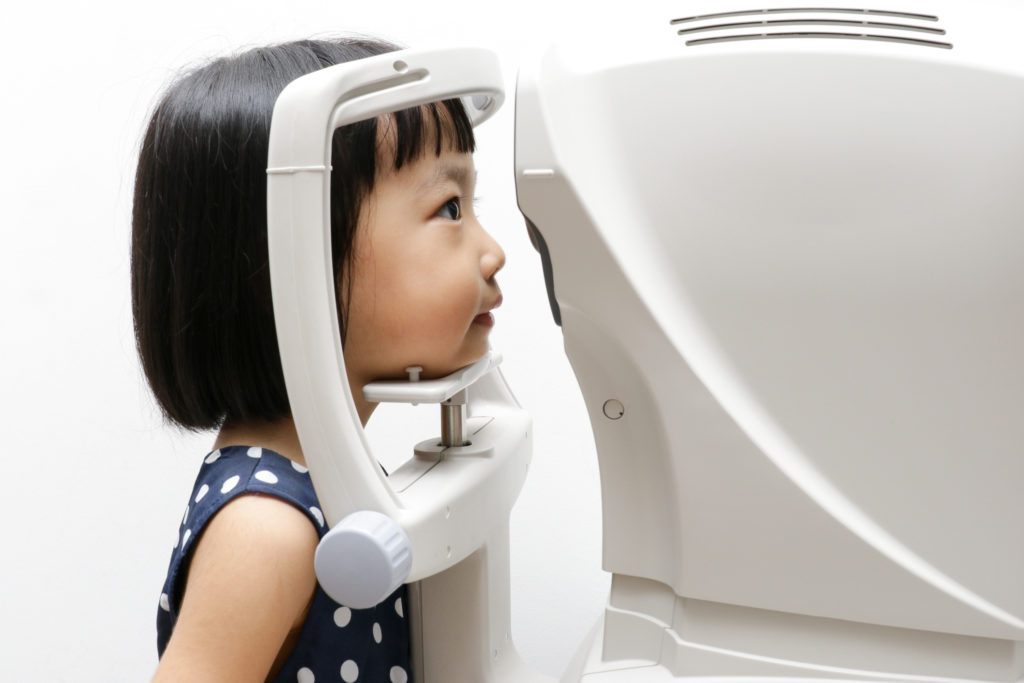By Jennifer Qayum, OD

July 10, 2019
Young children come with needs that are different from your adult patients. One aspect of those needs is office environment. Here’s how my pediatrics-only practice, which is part of Children’s Mercy Hospital in Kansas City, Mo., has created an office especially with kids in mind.
Keep the Exam Moving
Our practice schedules patients every 15 minutes. With our excellent support staff, this is adequate scheduling. When patients are coming in for their comprehensive exam, including dilation, they are in the office for 1.5-2 hours.
Fifteen minutes is the approximate face-to-face time providers spend with each patient. Our excellent support staff performs the majority of the work-up (visual acuity, stereoscopy, pupils, etc.). The provider may perform cover test and other exam elements prior to dilation. We then allow 30 minutes for dilation and will complete the remainder of the exam post-dilation.
New Resource
The important thing to remember with timing of pediatric exams is that children lose interest easily, so moving quickly benefits the patient and helps with exam efficiency.
In addition, with pediatric exams, I find myself relying more on my objective findings than subjective findings, so even if a patient is being uncooperative I know that I can obtain my objective findings efficiently.
Keep Them Entertained While They Wait
Our reception area has toys, children’s books and children’s television shows playing on TVs. These simple additions to the reception area are enough to keep patients at ease and entertained while they wait.
Our patients enjoy our toys the most. These are basic toys that should not be too costly for your practice. Something as simple as a rug with a city design and a few toy cars is enough to keep children entertained for their wait.
Stock Up on Essential Supplies in Exam Room
I often work with infants, uncooperative, special needs and non-verbal patients. I find the most important tool for obtaining a reliable pediatric exam to be cyclopentalate drops, as I often must rely on my objective findings to make a treatment plan.
Our exam rooms are furnished with little additional equipment compared to a typical exam lane. The tools I use for every patient include fixation targets, retinoscope and loose lenses, slit lamp and binocular indirect ophthalmoscope.
The most useful additional items are lighted spinning toys, which we purchase for about $3 a piece, and our M&S visual acuity system, which allows for playing cartoons and animal fixation targets. We play old movies, for which our clinics paid the copyright usage fee. This is so helpful for completing the exam!
Make the Exam Room Comfortable for Parents, Too
Parents always accompany young children to their exams. We have 3-4 extra chairs in our exam lanes for parents and additional family members (siblings often accompany the patient as well).
We have 20-foot exam lanes, so we are fortunate to have the space for these extra chairs.
Address Both Child & Parent
We address the parent individually and the patient individually. I find this to help both parties feel involved in the exam. Especially with our special needs and non-verbal patients, speaking directly to the patient often helps them feel calm during the exam.
I typically start my exam by speaking with the parents about why they have brought their child in for an exam.
After obtaining the patient history, I tell the parents that I will start the exam and will explain all findings at the conclusion of the exam. This helps minimize interruptions and distractions for the patient. I find that using encouraging words toward the patient, such as “Good job!,” or “You’re following directions so well!,” also signals to the parent that the exam is moving along smoothly.
For patients under five years of age, I usually have the patient sit in their parent’s lap for the exam. This helps the parent see what is happening with the exam and helps the patient feel more comfortable.
Other Articles to Explore
Take Time to Explain
I explain what I am doing during each step of the exam, using simple language. I find this helps calm anxieties (especially after the patient has had their cyclopentalate drops administered). Briefly explaining what each step of the exam is helps the patient know what to expect and also builds a trusting relationship with the patient. Most patients (and their parents) are interested in all of our “flashlights” and how I am using them to complete the exam.
Sooth Anxious Children
Many children are anxious at the exam because our office is a new environment and they have never had an eye exam before. Many children associate the doctor with shots or blood draws, so I reassure patients we will not be giving them any shots.
Another important thing is to not lie to the patient. Eye drops do burn, and if you tell your patient they will not, you will lose your patient’s trust. I find the most effective approach to administering eye drops is to tell the patient that they will burn for 10-20 seconds. Tricks to make them “burn less” include blinking (not rubbing!) and wiggling fingers and toes. This distracts the patient while the drops are soaking in.
Match Your Patient’s Energy Level
Move with them! I try to match my speed and energy level to the child’s. Sometimes children who cannot sit still perform the exam much better standing in the exam room.
We have colored blocks in our flooring, so I will sometimes direct the patient to stand on different colored squares for each stage of the exam. This keeps them moving while also allowing me to get the exam done.
 Jennifer Qayum, OD, is an optometrist in the optometric clinic at Children’s Mercy hospital in Kansas City, Mo. To contact her: jvqayum@cmh.edu
Jennifer Qayum, OD, is an optometrist in the optometric clinic at Children’s Mercy hospital in Kansas City, Mo. To contact her: jvqayum@cmh.edu





















